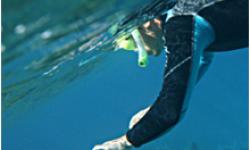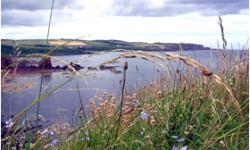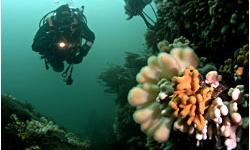St Abbs and Eyemouth Voluntary Marine Reserve, St Abbs, Scotland, United Kingdom
The National Trust for Scotland has a nature centre on the outskirts of the village of St Abbs, St Abbs and Eyemouth Voluntary Marine Reserve, the info center is packed with information about the Wildlife and history of St Abbs Head National Nature Reserve and the Marine Reserve.
There are also on site information boards at St Abb?s Head, St Abbs Harbour, Coldingham Sands, above Killedraughts Bay, Weasel Loch and Eyemouth Harbour.
The VMR also has a Mobile Marine Experience, in the form of a trailer decked out with information and activities to do with the Marine Reserve and its Wildlife. Look out for the trailer at various key sites along the length of the Marine Reserve but also further afield, as the Ranger takes it away from site to relevant festivals and shows.
When covered by the rising tide the shore life really comes to life and snorkelling is an excellent way to see the marine life of the shallows. Seaweeds buoyed up by the water, wave in the swell. Limpets and winkles crawl about, grazing in earnest before the falling tide forces them to close up once more. Barnacles and anemones open up to exploit the food-bearing water while fish and crabs hunt around for tasty titbits
If you are looking for stunning marine life, spectacular scenery above and below the water, and good visibility then St Abbs & Eyemouth is the place to come. Whatever your level of qualification or experience, there is a wide variety of different dive sites to choose from.
SHORE Diving
Relatively deep water close inshore and strong tidal movement combine to provide some of the best shore Diving in Britain in and around the Marine Reserve. In fact, the most famous dive site at St Abbs is actually a shore dive off the harbour wall.
Cathedral Rock, with its unique double archway, is a mere 50m swim from the shore and a must see for any first time visiting diver. However, if you decide to dive off the harbour wall you may well not get as far as Cathedral as you may be distracted by the maze of superb, kelp-topped gullies and vertical walls encrusted with marine life. Just about every species found on this area of coast can be seen here at some time including the wolf fish.
Seagull Rock, or Maw Carr, makes for a fantastic second dive at St Abbs as it does not involve the walk around the harbour wall, it is accessible direct from the car park, it has a maximum depth of about 12m, and is a pretty little dive with plenty of marine life to find.
St Abbs Harbour is not the only place where you can shore dive in the area; Greenends Gully and Weasel Loch at the Eyemouth end of the Reserve are well worth checking out. There is even a shore dive that is also a wreck dive, even if the remains of the Odense are fairly well spread out. In fact, wherever you can access the shore in or around the Marine Reserve will be worth a look.
BOAT Diving
Although the shore Diving is some of the best in the UK, there are many other excellent sites that can only be reached by boat. Probably the most popular dive site in the Marine Reserve is Anemone Gullies, just NW of the Lighthouse, where a series of rocky ridges run out from the cliffs. They range in depth from about 12m to 25m and are festooned with plumose anemones from which the site gets its name. Just minutes across the bay from St. Abbs harbour is Black Carrs, which is basically a tumble of huge boulders running from about 8m down. This is the best site in the Reserve for seeing wolf fish, with often several being found on one dive. The Hurkers, with its steep sided and undercut gullies, is probably the best dive site at the Eyemouth end of the Reserve. Also, remember that the Marine Reserve may have boundaries, but marine life doesn?t necessarily take any notice of these. Don't overlook the excellent dives that can be found off Fast Castle Head to the north west and Burnmouth to the south, all of which are easily accessed from St. Abbs or Eyemouth.
Surprisingly, for such an unforgiving stretch of coast, the Marine Reserve does not have a huge numbers of diveable wrecks, but with advances in technical Diving more are being discovered and explored in the vicinity all the time. The two most dived wrecks within the Reserve are the Alfred Erlandsen, at Ebb Carrs just SE of St Abbs harbour and the Glanmire just off the Lighthouse.
The coast path, which runs the full length of the Marine Reserve (and beyond), is an excellent way to access and enjoy the spectacular Berwickshire coastline. It also provides a series of fantastic vantage points for watching seabirds and looking for marine mammals. St Abb?s Head is the best place to go whatever the time of year. With cliffs rising some 300ft out of the sea you can see much further than if sitting at sea level, and as the headland juts out into the sea it also gives you a panoramic view. In the summer months there are also the sights, sounds and smells of a seabird colony in full swing. However, marine mammals and seabirds can be seen from anywhere along the coast path walking its length means you cover more ground, and so have more of a chance of seeing something.
The St Abbs Rangers offer a programme of guided walks and events between April and September. These are open to all, and are designed to be an enjoyable way of finding out more about the area?s amazing Wildlife.



St Abbs and Eyemouth Voluntary Marine Reserve reviews
Login to comment